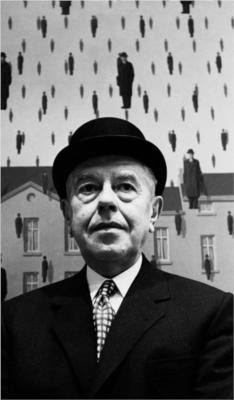Welcome to the new term!
New term means new opportunities to be better. And as every artist, in order to be better and improve our work we must do some research and look at other artist’s work so that we can find inspiration and create new artworks. For this reason, I believe that I should start this term with a research about the artist René Magritte, one of my favourites.
René Magritte (1898 - 1967)
René Magritte is one of the most well known surrealist artists. He is an Belgian artist, who worked in commercial advertising while making experiments in his paintings. Through everyday imagery and simple graphics as well as the setting of objects in unusual situations, this artist would provoke the mind of the observator.
Some of his most famous paintings include " The Treachery of Images" (1929), "The Lovers" (1928), "Golconda" (1958),"The Son of the Man" (1964) and "The Human Condition (1964). In his painting "La Trahison des Images" (1929), which can be trasnlated as "The Trachery of Images", he painted a pipe and below he wrote "Ceci n'est pas une pipe" (This is not a pipe). This painting might seem controversial but it is true - that is not a pipe, but an image of an pipe. This painting reminds me the Installations of Joseph Kosuth in which, for instance, he distinguish the reality from an text and image. Both of these have as purpose "highlight the gap between language and meaning" (The Art Story, n.d.)
Another famous painting of him is "Les fils de l'homme" (The Son of the Man) which in the beginning was supposed to be a portrait of his friend Harry Torczyner. However, this evolved into hide the real identity of him - the location of the apple does not allow the viewer to see his true identity.
Magritte once said “I paint only the visible. It would be wrong therefore to look for the invisible…In it you can see a man with a face, which is something visible. You can also see an apple which is itself visible. However, there comes a time when one visible thing prevents you from seeing another" (Whitman, no. 124).
Magritte had a huge impact on movements that followed his death, including movements such as Conceptual Art and Pop Art. He was not only a artist but also a thinker. For this reason his style was entitle "Visual Thinking". Moreover, Magritte also influenced artists such as Andy Warhol, Martin Kippenberger, Robert Gober, Ed Ruscha, Duane Michals, Jasper Johns and so on.
At the moment, it is poosible to see many of his painitngs, drawings and sculptures in the Magritte Museum in Brussels. This museum has arround 200 artworks and it is considered the largest collection in the world of his works.
Reference:
Biography (2019) René Magritte Biography [online] Available from: https://www.biography.com/artist/rene-magritte [Accessed 08.04.2021]
The Art Story (n.d.) René Magritte - Biography and Legacy [online] Available from: https://www.theartstory.org/artist/magritte-rene/life-and-legacy/ [Accessed 08.04.2021]
Britannica Academic (2021) René Magritte [online] Available from: https://academic-eb-com.proxy.library.dmu.ac.uk/levels/collegiate/article/Ren%C3%A9-Magritte/50076 [Accessed 08.04.2021]
René Magritte (n.d.) The Treachery of Images, 1929 by Rene Magritte [online] Available from: https://www.renemagritte.org/the-treachery-of-images.jsp [Accessed 08.04.2021]
MFA Masterworks Fine Art (n.d.) René Magritte, Le fils de l'homme (The Son of Man) [online] Available from: https://www.masterworksfineart.com/artists/rene-magritte/lithograph/le-fils-de-lhomme-the-son-of-man-3/id/W-5690 [Accessed 08.04.2021]
Rene Magritte (n.d.), Rene Magritte Biography [online] Available from: http://www.rene-magritte.com/biography/ [Accessed 09.04.2021]




Comments
Post a Comment